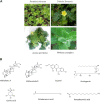The use of African medicinal plants in cancer management
- PMID: 36865913
- PMCID: PMC9971233
- DOI: 10.3389/fphar.2023.1122388
The use of African medicinal plants in cancer management
Abstract
Cancer is the third leading cause of premature death in sub-Saharan Africa. Cervical cancer has the highest number of incidences in sub-Saharan Africa due to high HIV prevalence (70% of global cases) in African countries which is linked to increasing the risk of developing cervical cancer, and the continuous high risk of being infected with Human papillomavirus In 2020, the risk of dying from cancer amongst women was higher in Eastern Africa (11%) than it was in Northern America (7.4%). Plants continue to provide unlimited pharmacological bioactive compounds that are used to manage various illnesses, including cancer. By reviewing the literature, we provide an inventory of African plants with reported anticancer activity and evidence supporting their use in cancer management. In this review, we report 23 plants that have been used for cancer management in Africa, where the anticancer extracts are usually prepared from barks, fruits, leaves, roots, and stems of these plants. Extensive information is reported about the bioactive compounds present in these plants as well as their potential activities against various forms of cancer. However, information on the anticancer properties of other African medicinal plants is insufficient. Therefore, there is a need to isolate and evaluate the anticancer potential of bioactive compounds from other African medicinal plants. Further studies on these plants will allow the elucidation of their anticancer mechanisms of action and allow the identification of phytochemicals that are responsible for their anticancer properties. Overall, this review provides consolidated and extensive information not only on diverse medicinal plants of Africa but on the different types of cancer that these plants are used to manage and the diverse mechanisms and pathways that are involved during cancer alleviation.
Keywords: anticancer mechanism; bioactive compounds; cancer; cancer management; medicinal plants; sub-Saharan Africa.
Copyright © 2023 Gaobotse, Venkataraman, Brown, Masisi, Kwape, Nkwe, Rantong and Makhzoum.
Conflict of interest statement
The authors declare that the research was conducted in the absence of any commercial or financial relationships that could be construed as a potential conflict of interest.
Figures


Similar articles
-
Contribution of Sub-Saharan African medicinal plants to cancer research: Scientific basis 2013-2023.Pharmacol Res. 2024 Apr;202:107138. doi: 10.1016/j.phrs.2024.107138. Epub 2024 Mar 11. Pharmacol Res. 2024. PMID: 38467241 Review.
-
Ethnomedicinal uses, biological activities, phytochemistry and conservation of African ginger (Siphonochilus aethiopicus): A commercially important and endangered medicinal plant.J Ethnopharmacol. 2021 Feb 10;266:113459. doi: 10.1016/j.jep.2020.113459. Epub 2020 Oct 8. J Ethnopharmacol. 2021. PMID: 33039627 Review.
-
A review on traditionally used South African medicinal plants, their secondary metabolites and their potential development into anticancer agents.J Ethnopharmacol. 2020 Oct 28;261:113101. doi: 10.1016/j.jep.2020.113101. Epub 2020 Jun 17. J Ethnopharmacol. 2020. PMID: 32562876 Review.
-
Traditional Uses, Pharmacological, and Phytochemical Studies of Euphorbia: A Review.Curr Top Med Chem. 2022;22(19):1553-1570. doi: 10.2174/1568026622666220713143436. Curr Top Med Chem. 2022. PMID: 35838213 Review.
-
Ethnobotany, phytochemistry and pharmacology of Arctotis arctotoides (L.f.) O. Hoffm.: A review.J Ethnopharmacol. 2018 Jun 28;220:294-320. doi: 10.1016/j.jep.2018.01.011. Epub 2018 Jan 11. J Ethnopharmacol. 2018. PMID: 29331315 Review.
Cited by
-
Network pharmacology, molecular docking, and in vitro study on Aspilia pluriseta against prostate cancer.BMC Complement Med Ther. 2024 Sep 20;24(1):338. doi: 10.1186/s12906-024-04642-8. BMC Complement Med Ther. 2024. PMID: 39304868 Free PMC article.
-
Therapeutic Potential of Prunus Species in Gastrointestinal Oncology.Cancers (Basel). 2025 Mar 10;17(6):938. doi: 10.3390/cancers17060938. Cancers (Basel). 2025. PMID: 40149274 Free PMC article. Review.
-
Computational investigation and experimental validation of the molecular mechanism of Solanecio mannii aqueous roots extract against cervical cancer.PLoS One. 2025 May 30;20(5):e0323680. doi: 10.1371/journal.pone.0323680. eCollection 2025. PLoS One. 2025. PMID: 40446016 Free PMC article.
-
Incredible use of plant-derived bioactives as anticancer agents.RSC Adv. 2025 Jan 20;15(3):1721-1746. doi: 10.1039/d4ra05089d. eCollection 2025 Jan 16. RSC Adv. 2025. PMID: 39835210 Free PMC article. Review.
-
Pulmonary hypertension and the potential of 'drug' repurposing: A case for African medicinal plants.Afr J Thorac Crit Care Med. 2024 Jul 4;30(2):e1352. doi: 10.7196/AJTCCM.2024.v30i2.1352. eCollection 2024. Afr J Thorac Crit Care Med. 2024. PMID: 39171151 Free PMC article. Review.
References
-
- Abebe W. (2016). An overview of Ethiopian traditional medicinal plants used for cancer treatment. Eur. J. Med. Plants 14, 1–16. 10.9734/ejmp/2016/25670 - DOI
-
- Abutaha N. (2015). In vitro antiproliferative activity of partially purified Withania somnifera fruit extract on different cancer cell lines. J. Balk. Union Oncol. 20, 625–630. - PubMed
Publication types
LinkOut - more resources
Full Text Sources

